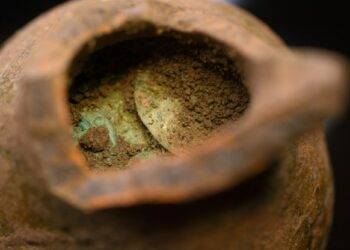A remarkable archaeological discovery was made on a Baltic beach in Poland when a metal detectorist unearthed an exquisitely decorated bronze dagger believed to be approximately 2,800 years old. The artifact, dating back to the Hallstatt period of the early Iron Age, was found embedded in a clay formation that had detached from a cliff. Experts describe the find as unprecedented in Poland due to its intricate craftsmanship and potential cultural significance.
Accidental Discovery Leads to a Major Archaeological Find
Jacek Ukowski, the president of the Stowarzyszenie Eksploracyjne na Rzecz Ratowania Zabytków im. Św. Korduli (Exploratory Association for the Preservation of Monuments of St. Cordula), made the discovery during a routine exploration along the western Polish coastline. He was accompanied by Katarzyna Herdzik when his metal detector signaled the presence of metal within the clay.
“This is my most valuable find, and it happened entirely by chance,” Ukowski said. “The cliff had eroded, and this piece must have fallen from above. I walked into the area with my metal detector because I heard the signal.”
Upon recognizing the significance of the object, Ukowski immediately contacted the director of the Museum of the History of Kamień Land, Grzegorz Kurka. The artifact was carefully secured and transferred to the museum, where it is currently undergoing analysis.
A ‘True Masterpiece’ from the Early Iron Age
Measuring 24.2 cm in length, the dagger is considered an extraordinary example of ancient metalwork. Its entire surface is covered in elaborate engravings, including crescent-shaped patterns and star-like crosses. A central decorative element runs down the blade, potentially symbolizing constellations. The hilt is adorned with alternating patterns, tapering into a pointed pommel.
“This is a true work of art,” said Kurka. “In terms of craftsmanship, it is of the highest quality. Each engraved element is unique. I have never seen a dagger like this in Poland.”
Historical and Ritual Significance
Experts suggest the dagger could have been used in ceremonial contexts rather than combat. The elaborate decorations and the presence of celestial motifs hint at a possible connection to solar worship, a belief system that was prevalent in various early European cultures.
“The dagger’s ornamentation may indicate religious significance,” Kurka explained. “It could have belonged to a high-status warrior or been used in rituals. Further analysis will help determine whether it was ever used in battle or if it served purely ceremonial purposes.”
The museum plans to conduct metallurgical testing to analyze the dagger’s composition. Researchers will assess the proportions of copper and tin in the alloy to determine its origin. Preliminary hypotheses suggest the artifact might have been imported, possibly originating from a workshop in southern Europe.
A Window into the Past
This discovery offers valuable insights into the history of Poland’s western coastal region. The Hallstatt period, spanning roughly 800–450 BCE, was a crucial phase in early European civilization, marked by advancements in metalworking and trade networks. While similar daggers have been found in Central and Southern Europe, their presence in Poland is rare.
“This find sheds light on the dynamic history of Western Pomerania,” Kurka added. “It suggests the region had connections to broader cultural and trade networks much earlier than previously thought.”
Previous Discoveries by the Same Explorer
Ukowski is no stranger to significant archaeological finds. In the past, he has discovered medieval artifacts, including two papal bulls—lead seals attached to official Vatican documents. However, he admitted that finding an object dating back three millennia was an entirely new experience.
“This is a completely different level,” he said. “I’ve found objects from a thousand years ago, but never something from three thousand years ago.”
Next Steps and Future Exhibition
For now, the exact location of the find remains undisclosed to protect the site. The artifact will be examined further, and the museum hopes to display it in a future exhibition. Local authorities and the Provincial Conservator of Monuments in Szczecin have been notified, and discussions are underway regarding which institution will ultimately house the dagger.
“This is a spectacular piece of history,” Kurka concluded. “Regardless of where it ends up, it will offer the public a glimpse into the craftsmanship and beliefs of people who lived nearly 3,000 years ago.”
As archaeologists continue their analysis, the ancient dagger may yet reveal more about the rich, interconnected past of early European civilizations.


















